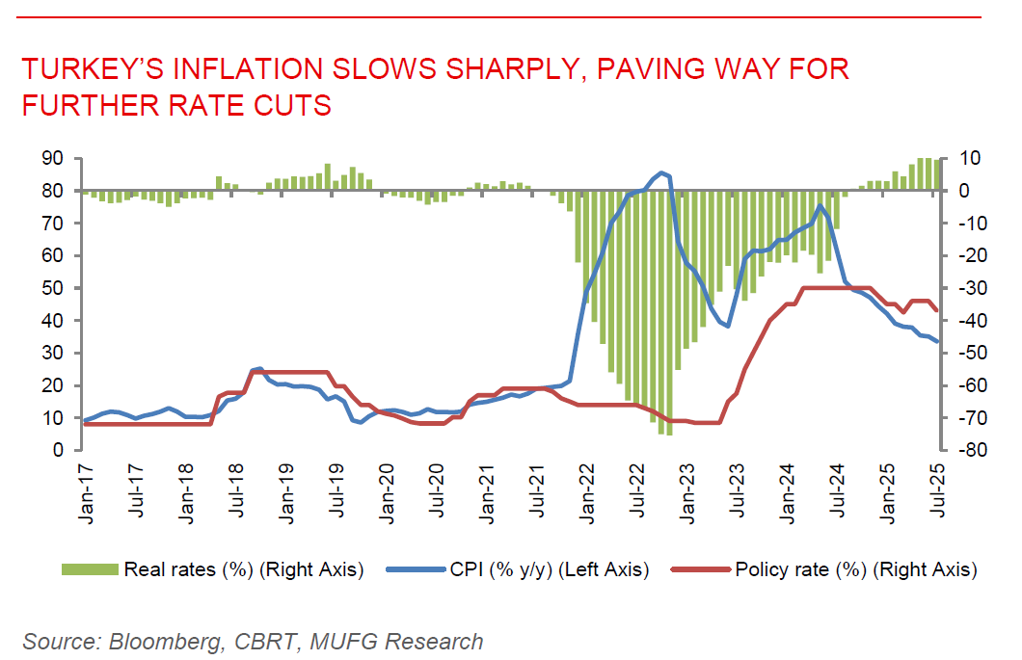To read the full report, please download the PDF above.
Middle East Daily
SOOJIN KIM
Research Analyst
DIFC Branch – Dubai
T: +44(4)387 5031
E: soojin.kim@ae.mufg.jp
MUFG Bank, Ltd. and MUFG Securities plc
A member of MUFG, a global financial group
Middle East Daily
Geopolitical tensions and OPEC+ output hike keep oil market on edge. Oil prices steadied after a three-day decline, as markets weighed the potential disruption to Russian crude supplies. Brent hovered below USD69/b and WTI near USD66/b following a 6% drop over recent sessions. The downturn was fuelled by concerns over slowing US economic growth, OPEC+ plans to ease supply curbs, and a looming crude surplus. However, President Trump’s threat to impose higher tariffs on Indian exports in retaliation for its continued imports of Russian oil introduced new uncertainty. India, now Russia’s top seaborne crude buyer, strongly opposed the move, while secondary tariffs on multiple buyers could further destabilise the market. Still, OPEC+ producers, especially in the Middle East, may step in to fill any potential supply gap, having already agreed to raise output starting in September. The market remains caught between bearish fundamentals and geopolitical risk.
Gold holds gains on rate cut bets and Fed independence concerns. Gold edged higher as traders grew more confident that the US Fed will cut interest rates at its September meeting. Gold was steady around USD3,375/oz in early Asian trading, with market expectations now showing a 98% likelihood of a rate cut, fuelled by weaker than expected US employment data that raised economic concerns. Concerns over the Fed’s independence are also boosting gold’s safe-haven appeal, especially after Fed governor Adriana Kugler’s resignation, which opens the door for President Trump to appoint a pro-rate cut replacement. So far this year, gold has surged nearly 30% on the back of trade tensions, geopolitical instability, central bank purchases, and expectations of monetary easing.
MIDDLE EAST - CREDIT TRADING
End of day comment – 04 August 2025. A surprisingly busy day with the market working on consolidating across sectors after Friday's rates move shifting both spreads and cash prices. We had solid net buying today but plenty of two way with profit taking from cash price accounts more than balanced out with index and spread based accounts trying to find bargains. For Saudi Arabia, a lot of action in Fins today with seniors, LT2, and AT1s all busy here. Sub debt is lagging the spread move as local accounts who can't own it long term anchor the offered side, but value is showing up. Qatar sovereign bonds were the one name I saw plenty of supply in today. Another tick lower in the EMBI indices and driving accounts out of their holdings to just stay market weight. On the balance it was more long end than short end today, which, given the rates move, makes some sense. For Bahrain, The curve widened out versus Friday's close more on rates. As has been the story through this rally I have seen very little direct buying here past the 2030 maturities. The new 33 sukuk printed above 101 for the first time, but is still going out +5bps.
MIDDLE EAST - MACRO / MARKETS
IMF endorses Saudi Arabia’s economic strategy as diversification gains traction. The IMF concluded its Article IV consultation for Saudi Arabia, commending the country’s robust economic performance and resilience amid global uncertainty, supported by ongoing Vision 2030 reforms. Non-oil GDP grew by 4.5% in 2024, driven by domestic demand and key sectors like retail and construction, while oil GDP declined due to OPEC+ cuts. Inflation stayed low, unemployment reached record lows, and the banking sector remained strong. The IMF projects continued non-oil growth above 3.5% in the medium term, despite emerging twin deficits and downside risks from global oil demand and regional tensions. Director supported a countercyclical fiscal approach in the near term, while recommending gradual fiscal consolidation, stronger fiscal institutions, and enhanced financial stability tools. They also welcomed sustained improvements in governance, labour participation, SME financing, and Saudi Arabia’s growing leadership on global economic issues.
Turkey’s inflation slows sharply, paving way for further rate cuts. Turkish inflation slowed more than expected in July, easing to 33.5% y/y from 35.1% y/y, and bolstering the Central Bank of Turkey (CBRT)’s recent decision to resume interest rate cuts. The slowdown was driven largely by unexpectedly low clothing and food prices, despite a monthly inflation uptick to 2.1% due to tax hikes and energy price increases. The data has strengthened expectations for another significant rate cut in September, following July’s cut from 46.0% to 43.0%. while the CBRT targets year-end inflation of 24.0%, many anticipate a closer figure of 30.0%. challenges remain in sectors like housing and education, which saw steep price increases. Governor Fatih Karahan is expected to update the inflation outlook on 14 August, as the central bank continues navigating inflation dynamics and political pressures following previous market disruption.

